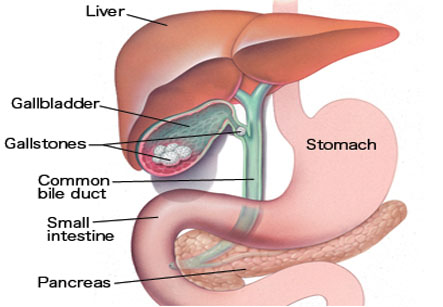Cholecystectomy
Introduction
Gallbladder is a small bile-producing organ situated in the abdomen attached to the lower surface of liver. Cholecystectomy is a medical name given to surgical removal of gallbladder.
The gallbladder may be needed to be removed in case of:
• Presence of gallstones causing pain due to inflammation or infection of the gallbladder
• Jaundice (yellowing of the skin or the white in the eyes) caused by a gallstones blocking the bile duct
• Inflammation of the pancreas (pancreatitis) due to gallstones
• Cancer of the gallbladder
Your gallbladder collects and stores bile — a digestive fluid produced in your liver

There are two surgical techniques used to remove the gallbladder. They include:
• Laparoscopic cholecystectomy – in this method, the gallbladder is removed through multiple small cuts in the abdomenby inserting small instruments.
• Open cholecystectomy – the gallbladder is removed through one large cut in the abdomen, using a surgical technique called open surgery.
Diagnosis of gallstones:
The doctor first asks about the symptoms, followed by complete physical examination. He or she may also ask about the medical history. The doctor may press gently with his or her fingers over the right-hand side of the abdomen. This area may be tender if there is inflammation of gallbladder.
Further tests may be ordered including:
1. Blood and urine tests to check the liver function
2. An ultrasound scan of the abdomen
3. Endoscopic retrograde cholangio-pancreatography (ERCP) – this is a detailed X-ray study of the pancreas and bile ducts using a narrow, flexible, tube-like telescopic camera called as endoscope.
4. Hepatobiliaryimino-diacetic acid scan – X-ray images of the gallbladder are taken following injection with iodine dye contrast.
Preparation:
• Smoking should be stopped as smoking increases the risk of getting a chest and wound infection. Gallbladder removal using keyhole surgery is routinely done as a day-care procedure but the patient may need to stay overnight in hospital.
• The patient is instructed not to eat or drink anything for about six hours before the surgery.
• At the hospital, the nurse may check the heart rate, blood pressure and may test the urine.
• The patient is asked to sign a consent form for giving permission for the procedure to go ahead.
• Compression stockings or injecting an anticlotting medication called heparin may be given to prevent blood clots forming in the veins of the legs.
Procedure:
• Keyhole surgery is a preferred approach to remove the gallbladder and it usually takes between 30 and 90 minutes. Four small cuts are made in the abdomen. The surgeon then inflates the abdomen using harmless carbon dioxide gas to create space and also to make it easier to see the internal organs. The surgeon then passes a laparoscope (a long, thin telescope with a light and camera lens at the tip) through one of the cuts guide the surgery on a video monitor.
• Specially adapted surgical instruments are inserted through the other cuts to remove the gallbladder.
• At the end of the surgery, the carbon dioxide gas is allowed to escape and the instruments are removed. The wound is closed with stitches or metal clips and covered with a dressing.
• In open cholecystectomy, the gallbladder is removed through one large incision in the abdomen. This technique is called as open surgery. It is a more invasive operation than keyhole surgery. This surgery needs a longer hospital stay as well as recovery time.
After the surgery:
• The patient may need pain relief to reduce any discomfort as the anesthetic wears off.
• The patient is usually able to go home when ready but someone should be arranged to drive you home. A friend or relative should be present with you for the first 24 hours after the surgery.
• A date may be given for a follow-up appointment.
• If general anesthesia is used, the patient must not drive, drink alcohol, operate machinery or sign legal documents for 24 hours afterwards.
• If gallstones have passed into the bile ducts and remain there after surgery, they can be removed by ERCP.
Recovery:
It usually takes between one or two weeks to make a full recovery from keyhole surgery, but this varies between individuals. Over-the-counter painkillers such as paracetamol or ibuprofen may be needed for pain.
Side-effects:
Side-effects are the unwanted but mostly temporary effects. They include:
1. Shoulder pain
2. Abdominal pain
3. Diarrhoea
Complications:
Complications are when problems occur during or after the procedure. These include:
1. Anesthesia-related complications such as breathing problems or allergy to the anaesthetic medication
2. Risks of any surgery such as bleeding, infection or a blood clot developing in a leg vein (deep vein thrombosis, DVT) which can move to lungs.
3. Need to convert a keyhole procedure to open surgery.
4. Specific complications of cholecystectomy may include:
• Pain in abdomen, bloating, and diarrhea
• Accidental damage to the bile duct or other organs
• Extensive bleeding
• Leakage of bile from the bile duct